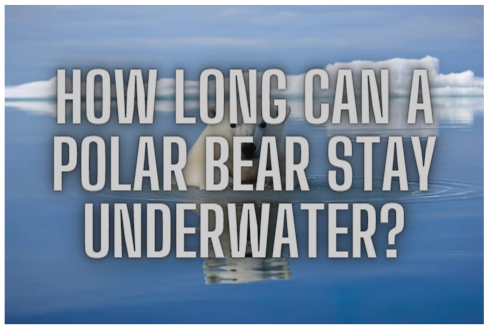Polar bears (Ursus maritimus) are renowned for their adaptation to the Arctic environment, excelling both on land and in the water. These majestic creatures are powerful swimmers and can spend a significant amount of time underwater in search of their primary prey, seals. In this article, we will delve into the remarkable diving abilities of polar bears, exploring their adaptations, physiological traits, and the factors that influence their underwater endurance.
Aquatic Adaptations
Polar bears are well-suited to an aquatic lifestyle, with several adaptations that facilitate their swimming and diving abilities. Their streamlined bodies, large front paws acting as paddles, and partially webbed toes enable efficient movement through water. Additionally, polar bears possess a thick layer of insulating blubber, which aids buoyancy and helps conserve heat in the frigid Arctic waters.
Diving Behavior and Prey
Polar bears primarily dive in search of their main prey, seals. They use a combination of surface swimming and submerging to approach seals resting on the ice or swimming beneath it. Polar bears can remain submerged for extended periods as they patiently stalk their prey before launching a surprise attack.
Duration and Depth of Dive
The duration of polar bear dives can vary depending on various factors, including the purpose of the dive, the availability of oxygen, and the distance to the prey. While there is limited scientific data on the exact duration of polar bear dives, observations suggest that dives typically range from 30 seconds to 2 minutes.
The depth of polar bear dives is also influenced by these factors. They are capable of diving to depths of around 15 feet (4.5 meters) when stalking prey or swimming underwater. However, polar bears are not known for deep or prolonged dives like some marine mammal species such as seals or whales.
Physiological Adaptations
Polar bears possess several physiological adaptations that enable them to stay underwater for extended periods. These include a higher blood volume, larger lungs, and a higher concentration of myoglobin—a protein that stores oxygen—in their muscles. These adaptations enhance their oxygen storage capacity, allowing them to tolerate longer dives.
Environmental Factors
Environmental factors, such as ice conditions, water temperature, and the availability of breathing holes, can influence the diving behavior of polar bears. Open leads or cracks in the ice provide access to breathing holes and areas where seals surface, aiding the hunting process. Thick ice or limited access to breathing holes may restrict the duration and frequency of dives.
Final Thoughts
Polar bears are remarkably adapted to their Arctic marine habitat, demonstrating impressive swimming and diving abilities. While the exact duration of their dives remains largely anecdotal, observations suggest that they can stay submerged for significant periods, ranging from seconds to a few minutes. Their adaptations, including streamlined bodies and physiological traits, contribute to their underwater endurance. Understanding the diving abilities of polar bears not only highlights their adaptability but also emphasizes the critical role of Arctic sea ice in their survival as it provides the platform for their hunting and diving activities.

